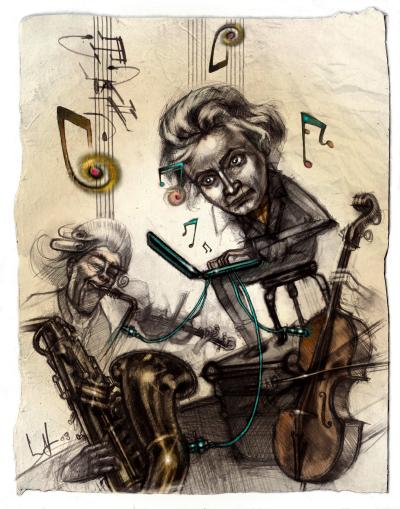You can call it “Ode to Joy 2008” because the basic theme is instantly recognizable but you can alter it in real-time, with ever-changing variety.
Unfortunately for old Ludwig himself, this musical vision comes 200 years too late, but you can still play with Beethoven’s works and you can do it with a completely new instrument: a computer program for the processing of sound, where the actual act of composing is an integral part of the instrument itself. And where the composition takes place simultaneously with a performance, in real time - live, as it is called in music-speak.

Beethoven never had it so good. This new computer program makes the actual act of composing an integral part of the instrument itself and can be done simultaneously with a performance, in real time. Illustration: Line Halsnes/NTNU Info
The developer is 36 year old Øyvind Brandtsegg, from the Norwegian University of Science and Technology (NTNU). Brandtsegg is a composer, a musician and computer programmer. The instrument is his PhD research.
It's a sound generator but he calls it a particle synthesizer. It takes a stanza – a guitar riff, a verse line, a drum solo, or any recorded sound – and splits the sound into a number of very short sound particles that can last for between 1 and 10 milliseconds. These fragments may be infinitely reshuffled, making it possible to vary the music with no change in the fundamental theme.
“It’s easy to change a bit of music into something that can’t be recognized. It’s the opposite that is the challenge: to create variations in which the musical theme remains clear,” says Brandtsegg.
Brandtsegg says he has created a new link between composition and improvisation with his new instrument, a way to rediscover the energy of a piece in a new and (perhaps) better form. He’s doing something that jazz musicians have always done; they have a composition as the foundation, and then they go on stage and play variations on the basic theme.
But though it sounds like blasphemy, there are limits to what even Louis Armstrong can coax out of a trumpet. “This instrument allows me to expand the musical palette with new tonal variations and timbres. It is also the first time that the actual composition process can be controlled in real time”, Brandtsegg says.
Work that previously required paper, pencil and many hours can now be done in the blink of an eye, with an instrument on stage, says the composer. This allows for new ways of thinking about music composition. Brandtsegg himself is a graduate of the jazz programme at the NTNU Department of Music.
“Here I learned to improvise in the traditional way, but I wanted more. I understood that in order to achieve my goal, I had to learn about computer programming, and understand electronics”, he says.
Along the way, he has developed ImproSculpt, software that make it possible to sample surroundings during a presentation, and to control the process using a body sensor. He also plays the Marimba Lumina, a percussion instrument that has been electronically modified so that the player can alter the sound by the way he or she strikes the instrument.
In his efforts to develop his new computerized instrument, Brandtsegg has had to seek help elsewhere at the university. Scientists at the Department of Computer and Information Science have assisted him with its software architecture, and the acoustics group at the Department of Electronics and Telecommunications has helped with the development of particle synthesizer.




Comments